Walter Huss's plan to take back America for God, one precinct at a time, Part 1 of 2
Or, a reminder that Steve Bannon isn't the first right winger to propose a grassroots "precinct strategy" for a populist take over of the GOP
Draft description of “Key People” program in Walter Huss Papers, “Oregon” folder, Box 26. The document is undated, but based on where it was located in the folder I’d guess this was from the late 70s or early 80s.
Between the late 1960s and the late 1980s, Walter Huss produced and marketed several different iterations of a plan to train and mobilize a grassroots army of 2 million like-minded Christian Patriots placed in every single community across the country. With just one phone call the head of Huss’s “Key People” program, presumably Walter Huss, could activate via phone tree a nationwide Christian Patriot army that could snap into immediate action when the need arose. Was Huss’s “Key People” program an anti-democratic model for a fifth column theocratic militia designed to violently overthrow the federal government once full Communist/Jewish control had supposedly been achieved? Or was it a perfectly normal plan for democratically mobilizing like-minded citizens who could infuse the GOP with their authentic grassroots energy and persuade their fellow citizens to embrace their conservative vision of the nation’s future? The answer to both of those questions is “yes.”
I offer that admittedly coy “yes” because at this stage in my research I’m still experimenting with how best to characterize this “key person” program—Huss’s pet project during the most politically successful 20 years of his life. I’m inclined to say that the project was both democratic and anti-democratic simultaneously, and could take on one coloration or the other depending on who the audience was. When speaking to more moderate people Huss could emphasize that this was an entirely normal political mobilization via the existing system of parties and elections. When speaking to those who were “in the know” about the supposedly immanent Jewish/Communist takeover of America, then Huss’s plan looked like an excellent way to organize the inevitably necessary, well-armed resistance force capable of quickly neutralizing “the enemy.”
Hindsight also inflects how I think about what Huss was up to. We know that Huss’s Key People program never matured into anything that could pose a serious threat to the US government. Because we know this, there’s an understandable temptation to dismiss Huss’s grandiose plans as the the ineffectual rantings of a kook. But as we’ll see, Huss’s plans meshed with (and may have even played some role in informing) the organizational strategies deployed by the Moral Majority in the Reagan era. As one relatively minor, local player in the growing grassroots evangelical insurgency within the GOP, Huss shows us the darker, more menacingly violent and authoritarian energies that often underlay the apocalyptic imaginary of far right evangelicalism.
In what follows I’ll share some fliers depicting different iterations of Huss’s “Key People” program and offer some assessments as to what it all means. At the very least, these documents offer a fascinating window into the mind of a far right grassroots activist who was trying to solve the very challenging problem of how to effect political change as a) an outsider to the dominant political culture with little money or social clout of his own, and b) someone who was supremely confident that the majority of his fellow citizens would agree with his white Christian nationalist politics if only they could be directly reached without the distorting filter of the mainstream "controlled” media.
Huss was a populist, but a profoundly anti-pluralist one. We shouldn’t allow the genuinely democratic, anti-elitist, and grassroots aspects of his “key people” project to overshadow the radically exclusionary features of it. It’s precisely this combination of populism and anti-pluralism that puts Huss squarely inside the deeply-rooted far right (or “fascist”) political tradition that historian Joseph Fronczak has dubbed “participatory anti-democracy.”
Huss seems to have hatched his “Key People” idea soon after his idol, Barry Goldwater, got shellacked (61%-38%) in the 1964 election.
This is a campaign song that Huss and his friend Jim Bisel, Portland’s leading Christian ventriloquist, recorded in the summer of 1964. I’ll share more stories about Jim Bisel and his dummy named Tony in a later installment of Righlandia.
Goldwater’s loss inspired Republican moderates in Oregon to reassert themselves against the Goldwaterite insurgents like Huss who had hoped to capitalize on the momentum of 1964 to keep pushing the party to the right. In 1965 future GOP Senator Bob Packwood founded the Dorchester Conference which was designed to chart a decidedly moderate, non-Hussian, and hence more electable, course for the OR GOP. But as Huss saw it, the problem wasn’t that Goldwater’s extremism scared voters away, it was that he’d been unfairly maligned by the liberal media and given only lukewarm support by the institutional OR GOP. Goldwater didn’t lose the election so much as he’d never really been given a fair chance to compete. If only conservatives like Huss could get their Goldwater-ite message out to the good people of Oregon and America, then surely the majority of their fellow Americans would warm to Barry’s brand of Republicanism!
Huss’s 1964 enthusiasm about the future of the GOP quickly cooled, dampened in part by the successful moderate counter-mobilization that swept into office very non-Hussian Republicans like Governor Tom McCall (1966-74) and Senators Mark Hatfield (1966-96) and Bob Packwood (1968-95). As the 1968 GOP primary approached, Huss backed Ronald Reagan as the best candidate to carry Goldwater’s movement forward as the POTUS nominee, but it quickly became clear that the nomination would go to either Nelson Rockefeller or (more likely) Richard Nixon. Huss thought both of them were as unacceptable as McCall, Packwood, and Hatfield who might as well have been Democrats. So in 1968 and 1972, while Huss continued to organize his grassroots insurgency to take over the OR GOP for the far right, he also devoted some of his time to supporting his preferred non-Republican (but, to his mind, truly “conservative”) Presidential candidates—George Wallace in 1968 and Bircher John Schmitz (American Independent Party candidate) in 1972. Huss still had his sights set on taking over the Republican Party, but he was not about to compromise his principles to support Republicans In Name Only like Nixon or, God forbid, Rockefeller.
It was in this context of disappointment ca. 1967 or 68 that Huss hatched his “key people” plan to mobilize a grassroots insurgency both in Oregon and across the nation that could eventually take back the GOP and the country for the Christian patriots like himself who he thought comprised the true “silent majority” of real Americans.
A few things stand out to me in this flier. First, Huss knew that he needed to educate his audience about the nuts and bolts of how parties and elections work. The project was aimed at previously apolitical people and sought to activate them as Christians to get involved in politics. Second, note how Huss tapped into peoples’ perceptions that they as Christians were being belittled, if not actively persecuted, by “an ungodly clique.” Readers of Rightlandia will know that Huss meant that phrase as a stand in for “Jews,” but he was smart enough to use the dogwhistle for those who hadn’t been fully “educated” yet. Third, note the David and Goliath story Huss invited his readers to imagine themselves into. Just as an individual could use their modest power of prayer to push back against the Satanic darkness, one could also exert one’s modest agency by participating in the political process as a precinct committeeman or woman. It wasn’t showy, but it just might be the one pebble that touches off the avalanche of positive Godly change that could redeem a horribly fallen world. Fourth, note how he encouraged people to serve as either Democratic or Republican precinct captains. Walter and Rosalie had been registered Democrats in the late 1940s, and there were still many quite conservative Democrats around in 1968.1 Though Huss had long given up on the Democrats, he saw this political project as one that could be pursued inside either party. Finally, you gotta love Huss’s point that husbands and wives could vote for each other (and themselves) and thereby pretty much guarantee that they’d get elected since almost no one ever ran for these precinct positions and one only needed 2 votes to win. So yeah, was this completely within the rules of American democracy as set up at the time? Absolutely. Was this how a small number of extremists could quickly take over a political party from an overconfident establishment that wasn’t really paying attention to the grassroots mobilization of “kooks” like Walter Huss? For sure.
In the next iteration of the Key People program, aimed at the 1972 election cycle, Huss incorporated some new imagery and metaphors around the theme of good roots producing good fruits.
1972 was a rough political year for white Christian supremacists like Huss. Goldwater was a distant memory and Nixon was a perpetual disappointment. This explains why Huss opened this flier by acknowledging the frustratingly familiar cycle of right wing inspiration, “crusading” mobilization, inevitable failure, and demoralization. His reference to “Tulsa” was an interesting moment of subtle self-promotion. It referred to an invite he’d received to speak at a February 1971 “Leadership School” hosted by Billy James Hargis’s Christian Crusade in Tulsa. Other presenters included right wing luminaries John Schmitz, David Noebel (who wrote the book on The Beatles as Communist Hypnotizers), and General Edwin Walker. The fact that Huss, who’d been defeated handily in every election he ever ran up to that point, was presenting on how to win elections seems like par for the course for the far right ca. 1972. Most importantly, his participation in this event speaks to Huss’s efforts to work his way up the ladder of far right Christian activists. By making connections to more nationally-known figures like Hargis, Schmitz, Noebel, and Walker, Huss hoped to burnish his credentials back home in Oregon and also tap into the evolving political and financial networks that fueled the nationwide far right movement.
Christian Crusade Weekly, February 7, 1971. Full text available at archive.org.
Returning to Huss’s 1972 Key Person flier, note how its central focus was to unite the right, to find “unity in diversity” so that conservatives concerned about different issues could effectively combine and focus their efforts to “save America” by defeating their shared “enemy.” When one is battling a demonic enemy, there’s no room for democratic compromise or pragmatism. Note also how Huss encouraged his “Key People” to secure places on “committees, boards, councils, commissions, courts, legislatures, and the US Congress.” This was a “do everything and be everywhere” strategy aimed not at merely winning a Presidential election but rather at infiltrating every political institution in the nation, even at the most local levels. Huss depicts his Key People project as the sort of grassroots infrastructure that could implement Cleon Skousen’s vision of “the people,” disgusted by the moral rot in their society and their government, finally rising up to “throw the rascals out.” FWIW, 40 years later, right wing populist Glenn Beck would put Skousen’s books back on the nation’s bestseller lists as he marketed his Tea Party-affiliated organization as a purportedly grassroots movement aimed at “throwing the rascals out.”
The “Key People” project took an important step forward in 1974-5 when Huss got Arizona congressman (and fellow paranoid antisemite2) John Conlan interested in it. Though Conlan is little known today, in the mid-1970s he was a key figure in the earliest stages of the movement that would eventually become the Moral Majority. Huss met Conlan at an organizational meeting for the Christian Freedom Foundation in 1974, and then Huss served as the Oregon state coordinator of CFF for the next few years. One of Conlan’s main partners in this national project to organize conservative Christians to influence politics was Bill Bright, the founder of Campus Crusade for Christ and a major national figure on the evangelical right. The last half of the 1970s was the high water mark of Huss’s career as a figure in the national far right…and to his mind this partnership with big shots like sitting Congressman Conlan and Bill Bright might just be the sort of boost he needed to take his “Key People” program to the next level.
Several things stand out to me in that letter. First, I’m quite intrigued by Huss’s reference to the “elements of concealment and surprise” that Conlan had mentioned to him. What exactly Conlan was referring to, however, is impossible to discern from this letter (and I have no other information to go on at this point). Again we see the doubleness that I mentioned at the opening of this piece—this project looks simultaneously like the most normal sort of democratic organizing imaginable, but it also has more than a whiff of something clandestine, exclusionary, and potentially violent. This squares with Huss vision that his project would enable “the good people” of America to finally get organized and wield power—again, another vague term that one could interpret as either innocuous (of course “we” think that the people on “our side” are “the good people”) or menacing (by “good people” Huss clearly meant white conservative Christians opposed to the civil rights movement, feminism, gay rights, etc).
The apocalyptic imaginary that informed Huss’s project is evident in this passage of the letter.
“Or whatever.” [Cue ominous orchestral music.] I know the country’s political climate in the months following Watergate was pretty edgy, but setting up a political organization to prepare for a holocaust, a revolution, a change of government seat, or an economic collapse seems like some fairly extreme future tripping. I also think it’s safe to say that what Huss’s 2 million “key people” would NOT be doing after the projected holocaust or revolution is holding cookie and coffee receptions for their preferred candidates and putting up lawn signs. This letter has a real “prepping for a Red Dawn scenario” feel to it, which again would suggest that Huss envisioned this “key people” project as going far beyond regular old GOTV grassroots organizing aimed at securing slightly better electoral outcomes for Republicans in state elections ca. 1976.
Another important revelation in Huss’s 1974 letter to Conlan involves his overtures to HL Hunt and James S. Kemper. Every ambitious far right organizer like Huss knew they were always only one sugar daddy or sugar mama away from being able to live comfortably while pursuing their vocation as Christian patriot activists. Willis Carto glommed on to the $10 million estate of one of Thomas Edison’s granddaughters to fund his neo-Nazi activities. Right wing dog food tycoon D.B. Lewis left Dan Smoot a million bucks that financed his political activities in the 1960s and 70s. Countess Guardabassi, heir to a New England textile fortune who married an Italian fascist Count, generously funded the activities of white nationalists and antisemites like Gerald LK Smith, Pedro del Valle, and Revilo Oliver in the 1950s and 60s. Anyone like Huss who traveled in B-list, far right anti-communist circles in that era would have known just how many far right millionaires there were out there and how transformative it could be to get into their good graces.
This is another one of those situations where hindsight is a hinderance. Yes, Huss was not able to even get past HL Hunt and James Kemper’s secretaries, but not for lack of trying and not for a lack of plutocrats like those two who, given the right combinations of circumstances, might have decided to cut Huss a few life-changing checks.3 As we can see in the examples of DB Lewis and Countess Guardabassi, it’s not like rich right wingers have exercised excellent judgement about who they pick to be the recipients of their largesse. Huss’s failure to find a benefactor shouldn’t prevent us from taking him seriously as a historical actor.
The proof of concept for Huss’s “key people” precinct strategy came at the 1978 OR GOP convention when he was elected chairman. The short version of this very long story (which I’ll tell in a future post) is that Huss had been traveling to every county in the state since the early 1960s encouraging his fellow far right Christians to run for precinct captain and then come to the state convention and vote for Huss as chair. He’d fallen a bit short in 1968, 1970, 1972, 1974, and 1976…but then finally in 1978 he pulled it off, much to the chagrin of the moderate establishment. In his capacity as OR GOP chair, Huss flew to DC to participate in RNC meetings. He also got to meet personally with right wing luminaries like Barry Goldwater, Phil Crane, and Bircher Congressman Larry McDonald (who, FWIW, represented a district in Georgia that contained a significant chunk of Marjorie Taylor Greene’s current district). Huss also scored a 30-minute appearance on Pat Robertson’s 700 Club when he was in the DC area for the RNC meeting. On that nationally-televised show Huss promoted his Key People program and received (by his account) hundreds of letters from interested Christians across the country.
But Walter Huss’s moment of triumph, when it seemed as if his key people project was finally about to move from a victory in Oregon to a national roll out, was not to last. In the spring of 1979 the executive committee of the OR GOP booted Huss from his position as chair. Wasting no time, Huss quickly renamed his “key people” program “Help America” and he tried to capitalize upon his 15 minutes of national notoriety to raise money and attract more recruits for the project. Below is a fundraising letter he sent to his mailing list in the summer of 1979 that offers a fascinating account of the perceived successes of his past organizational work and his account of why he was ousted as OR GOP chair by a “coup” supported by his own former lieutenants. [The Committee for Good Government he’s addressing was one of the many “letterhead” organizations that Huss had set up in the 1970s.]
That letter is typically vague about what exactly the difference was between the OR GOP under Huss and the OR GOP previously. I think for Huss the only difference that really mattered was that the party was under the control of “good Christian people” like him who understood “the enemy” the nation was battling against. It’s notable that he describes his mobilization plan as being focused on 1% of the population, which is what his ~2 million key people would comprise of a national population of around 220 million in 1980. This points to the extent to which he really was not interested in democratic persuasion as a mechanism of political change. What he learned in the OR GOP is that a small number of committed activists could take over a major political institution and (at least temporarily) bend it to their will. If they could repeat that Oregon model of success in many states across the nation by taking over the Republican Party, then God would presumably do the rest and enable the triumphant 1% to impose His will upon the nation.
This was of course totally delusional, but the era of Reagan’s national ascendancy in 1979-80 was a time of great hope for far right evangelicals like Huss. The “One Nation Under God” program that Huss mentions was run by Rus Walton, a former speechwriter for and close associate of Ronald Reagan’s. Huss met multiple times with Walton and, like many evangelicals, he viewed Reagan as the second coming of Goldwater, as the first “true conservative” the GOP might nominate since 1964 and someone who could finally put Huss’s vision of good government into action. Just as he had with Hargis in 1971 and John Conlan in 1974-5, Huss looked to Rus Walton as the sort of national far right figure who could secure the connections and funding Huss would need to put his Key People program into full operation.
Needless to say, the Walton connection did not pan out and Huss slowly came to see Reagan’s presidency as a disappointment. When GHWBush got the nomination in 1988 Huss reverted back to his old mode of organizing locally to take over the OR GOP while supporting 3rd party Presidential candidates who weren’t tools of the communist/Jewish/globalist conspiracy like Bush was.
But I’m getting ahead of myself…there were still a few new iterations of the “key people” program to come in the 1980s with some fascinating new wrinkles (like a multi-level marketing version of the key people program), but in the interest of time I’ll share those in a future post.
I’ll. end with a few thoughts as to why I think this history of Huss's “Key People” program is relevant today.
As Thomas Zimmer argues in this excellent post, the central problem of American politics these days is NOT polarization. Rather, it is the ongoing right wing populist radicalization of the GOP against multi-racial democracy and religious pluralism.
One of the central goals of my research and writing on Walter Huss and the OR GOP is to understand how exactly that process of anti-democratic radicalization played out inside one state’s Republican Party over several decades. There was and is nothing natural or inevitable about the Republican Party moving ever rightward, it’s been the result of individual choices and complex processes that have hitherto drawn little attention because in order to see them you have to look not just at national figures who are more well-known and well-covered, but also at the grassroots activists in each state whose actions determined what direction their state parties would go in terms of ideology and what sort of candidates would be nominated.
The MAGA movement has made no secret of their plan to take over the GOP (and thereby the nation) one precinct at a time. ProPublica ran an excellent story on this two years ago, and there’s little sign that the MAGA momentum at the grassroots has abated at all. Trump has earned the allegiance of the GOP rank-and-file not just because of his showmanship, but also because his movement has managed to secure the loyalty of many county and state level GOP activists around the country. Any local Republican who wants to put the weight of their county or state GOP behind a candidate other than Trump or move the party more to the center would be pushing against significant headwinds, and very angry and menacing headwinds at that. As the saying goes, personnel is policy, and the MAGA movement has loyalists staffing so many low and medium level positions in the institutional GOP that it’s understandable why no other candidate has been able to make much headway with the GOP rank and file.
At some level this is just good old American politics. You want to have an influence on what your party stands for and who its candidates will be? Get involved as a precinct captain where few people ever put their name on the ballot and it takes only a few votes to get elected; and voila, you’re in the room where it happens. So far, so democratic.
But as that ProPublica piece on Bannon points out, the anti-democratic part is that these activists running for precinct captain are doing so in order to further the GOP’s plans to gain political power not by convincing more people to vote for Republicans, but rather by ratfucking elections as Trump tried to do after his loss in 2020. These so-called “election integrity” initiatives could involve placing “poll watchers” in heavily Democratic districts to try to intimidate voters, it could involve placing people in positions to watch the vote count who will make up stories about destroyed or miscounted ballots (as happened in Michigan and Pennsylvania in 2020), it could involve passing state-level laws or implementing policies that make voting slightly harder for poor voters or voters of color, it could involve changing the electoral process in order to put more control in the hands of heavily gerrymandered Republican state legislatures, or it could involve propaganda efforts to create just enough uncertainty about possible irregularities so as to bring into widespread question the legitimacy of the election. All of these strategies which are being pursued simultaneously require boots on the ground at as many polling places, ballot counting facilities, and state houses as possible. This strategy requires massive buy in from people in every state, every county, even every precinct.
In Oregon this “election integrity” initiative has taken the form of absurd claims that our mail in ballot system, which is one of the most accessible and fraud-proof systems in the country, is ackshually the way Democrats have been systematically stealing elections for decades now. Never mind that it was the Republican Party that most forcefully pushed for the mail in ballot system in the 1990s while Democrats often opposed it, and never mind that two Republican Secretaries of State have gone on record saying our state’s system is highly trustworthy and should be emulated by other states. Grassroots OR GOP activists these days are totally bought in to the idea that the 2020 election was stolen from Trump. The party has organized multiple events featuring prominent “election integrity experts” who train local activists on how to identify and publicize “fraud.” These experts are skilled propagandists who are quite effective at rallying rank and file Republicans to engage in all sorts of obstructionist (but technically legal) actions to try to create as much confusion and uncertainty around election results as possible. This is one important form that far right “participatory anti-democracy” is taking these days in the GOP grassroots.
The Trumpian GOP (in Oregon and elsewhere) has radicalized against democracy because a) most recognize that their beloved leader is reviled by many Americans and will have a hard time winning them back, b) they recognize that their Christian supremacist vision of the country speaks to a steadily shrinking minority of Americans who identify strongly as conservative Christians, and c) they’ve long been worried about the demographic trends that will make it increasingly difficult for a party that places white Christian identity politics at its center to win elections.
In a situation where most Trump-identified Republicans feel profoundly alienated from the nation’s media, mass culture, educational institutions, public health organizations, corporate culture, and scientific consensus on climate change; where can this “silent majority” turn to try to “save America?” The three institutions where Trump Republicans feel comfortably at home and in charge are inside the GOP, in right wing media safe spaces, and in conservative evangelical churches. Not that he bears any of the responsibility (or credit?) for how things are playing out today, but these were precisely the three institutions that Walter Huss prioritized in his efforts to leverage the power of the activated 1% of “key people” back in the 1960s, 70s, and 80s.
On this note, one of the most perplexing stories I heard about Huss came from a woman whose father was a Democratic union guy who would listen to Huss’s radio program in Eugene in 1964-5 and yell at the radio because he was so angered by it. When I asked how her father’s politics evolved after 1964-5 she told me that he voted for George Wallace in 1968 and 1972 because he couldn’t stand Humphrey or McGovern.
You’re probably familiar with that famous Barry Goldwater line about how he was terrified by the preachers who were trying to take over the Republican party. I strongly suspect that it was his fellow Arizonan John Conlan that Goldwater had in mind when he said that. Goldwater reviled Conlan, and had even taken the unusual step of weighing in on a GOP primary election to endorse Conlan’s opponent because he thought Conlan was such a nasty antisemite. It’s saying something when Mr. Republican and Mr. “Extremism in defense of liberty” Barry Goldwater thinks you’re a dangerously extreme Republican.
Huss’s money problems were quite severe in the mid-1970s. He was doing odd jobs as a plumber to make ends meet. He and Rosalie had fallen far behind on their mortgage payments. The person who held their mortgage (the daughter of the person they bought the house from in the early 1960s) sent them several letters in 1975 threatening legal action due to the fact that they were several years behind on their payments. Many conservative populists are quite wealthy people who merely pose as “salt of the earth,” but Huss came by his populist credentials honestly.




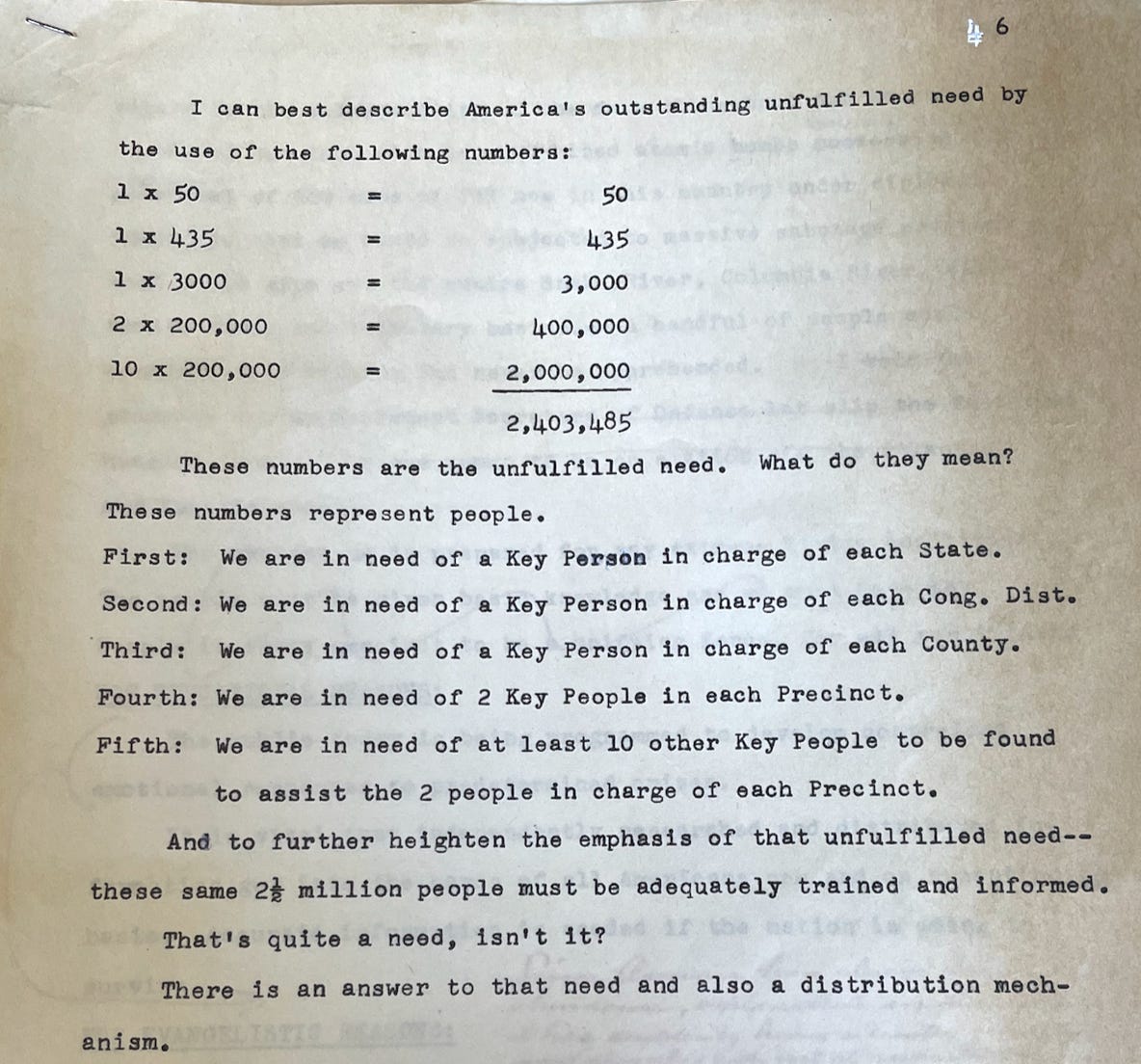
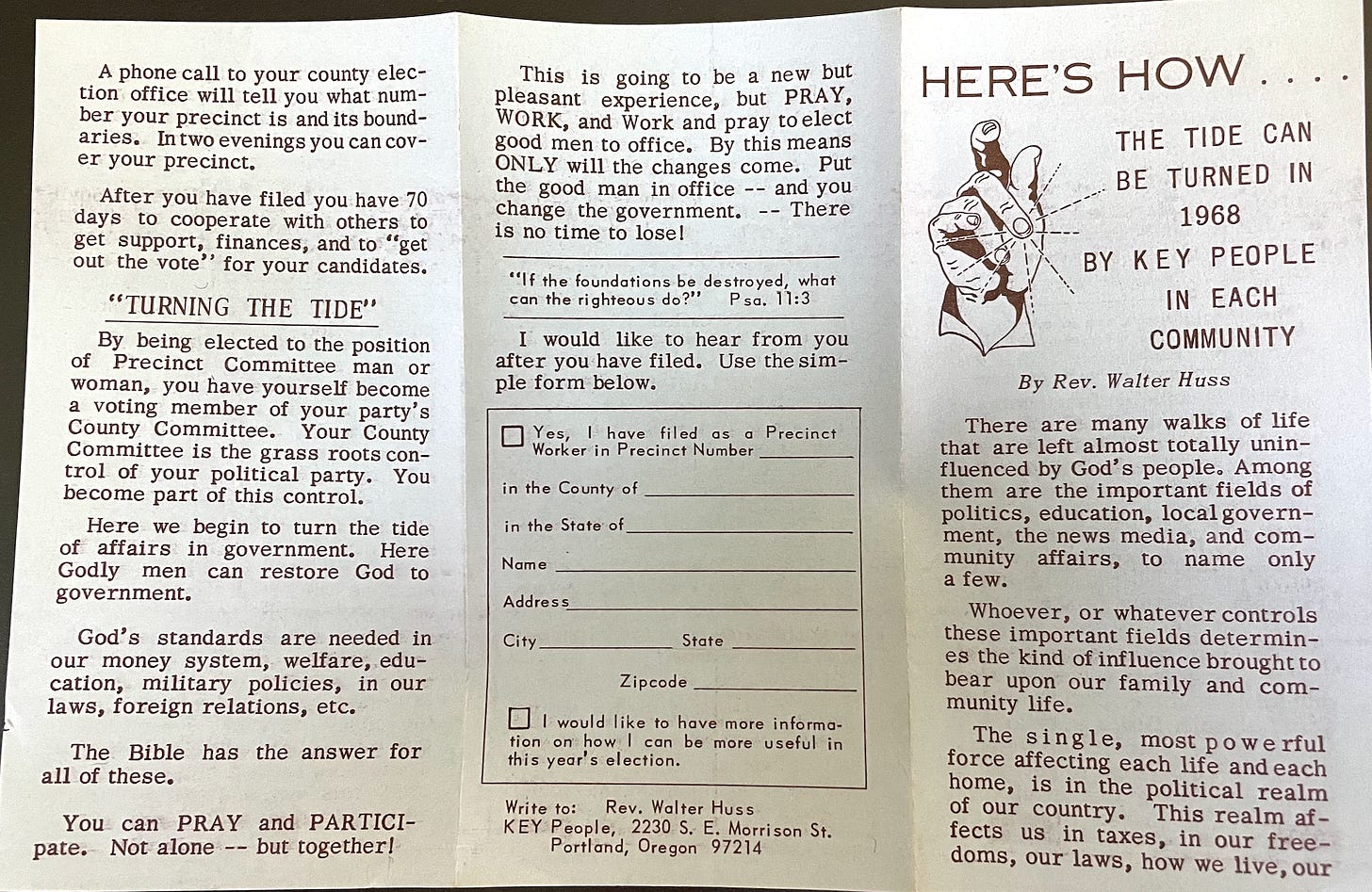
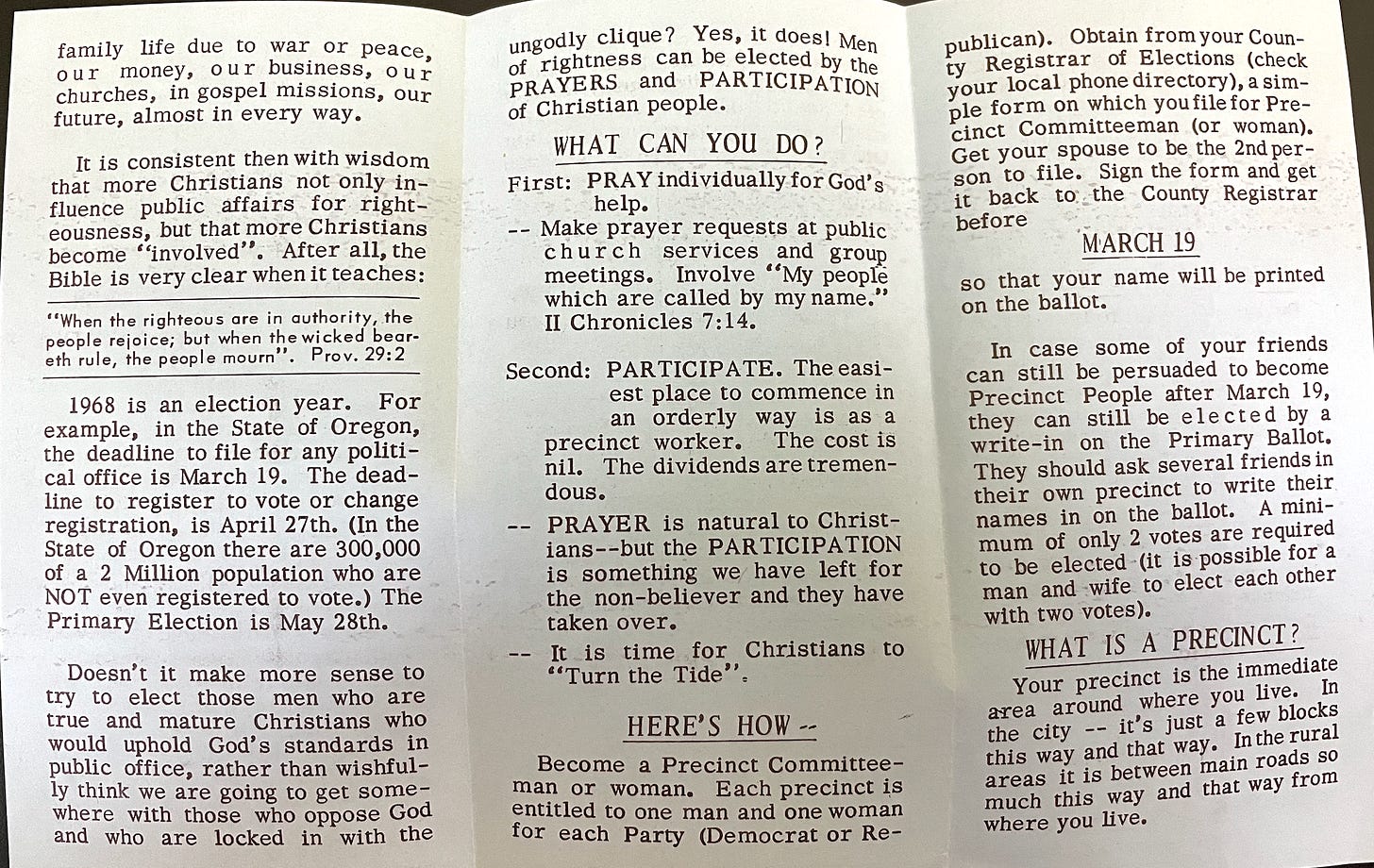

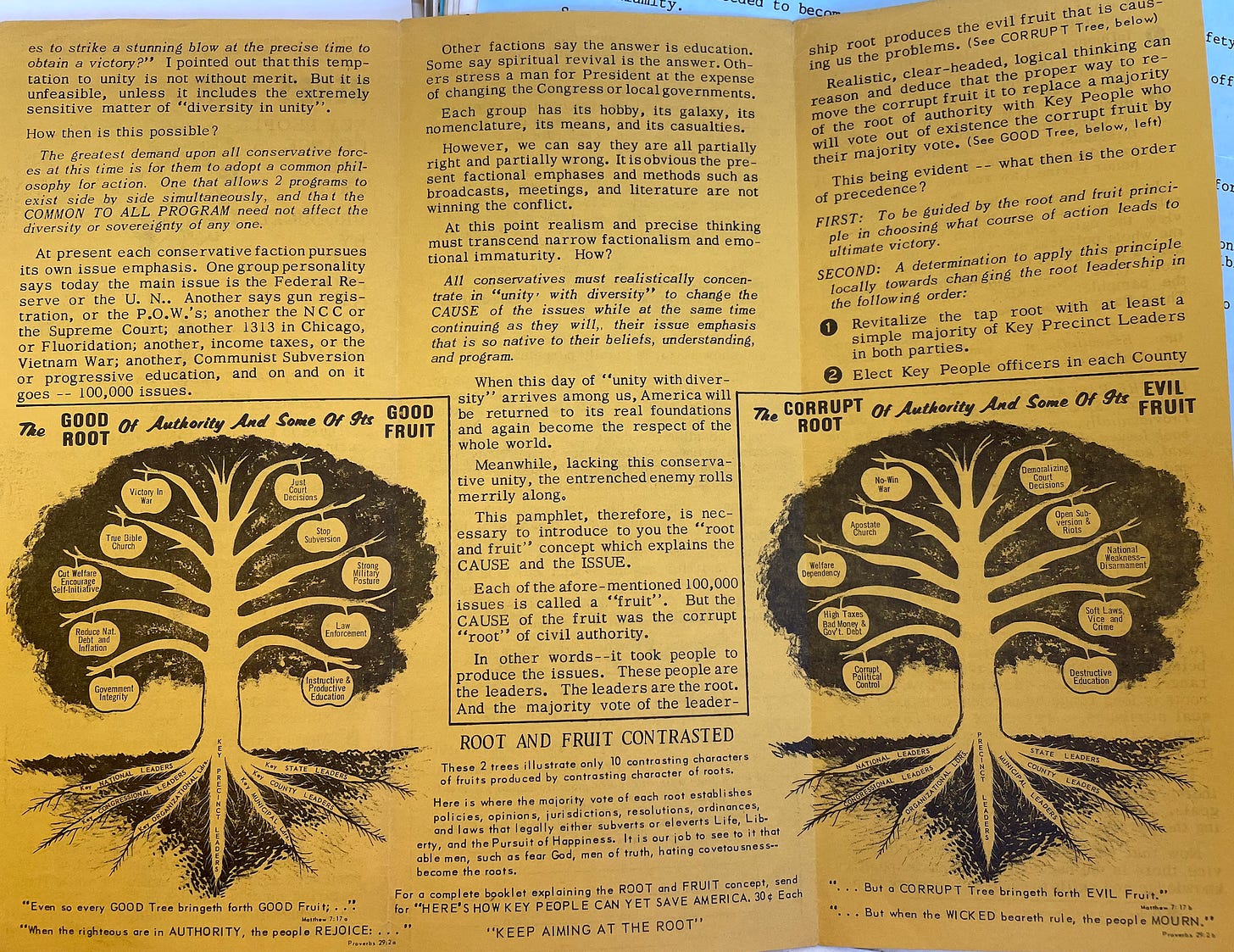
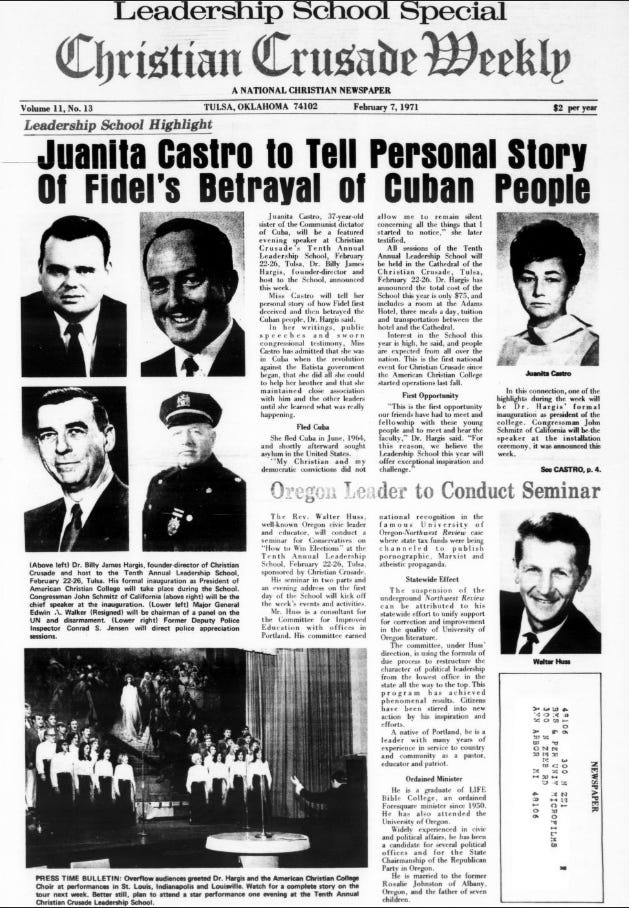
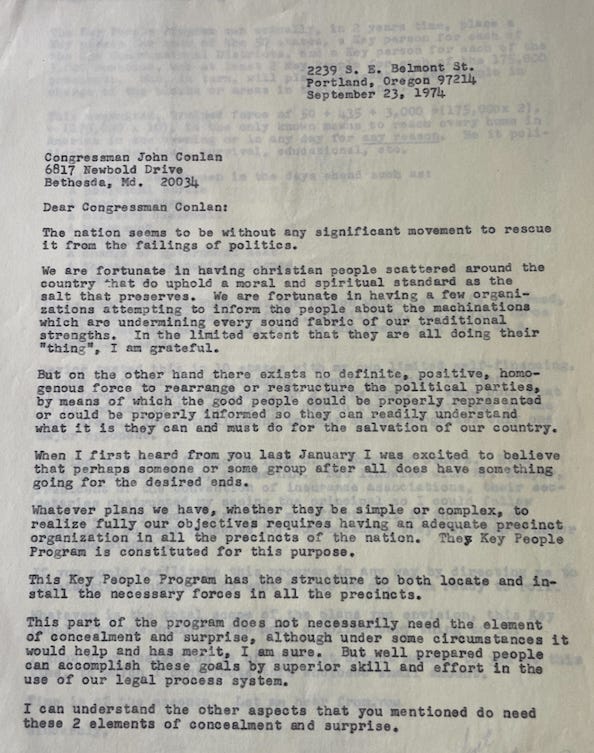
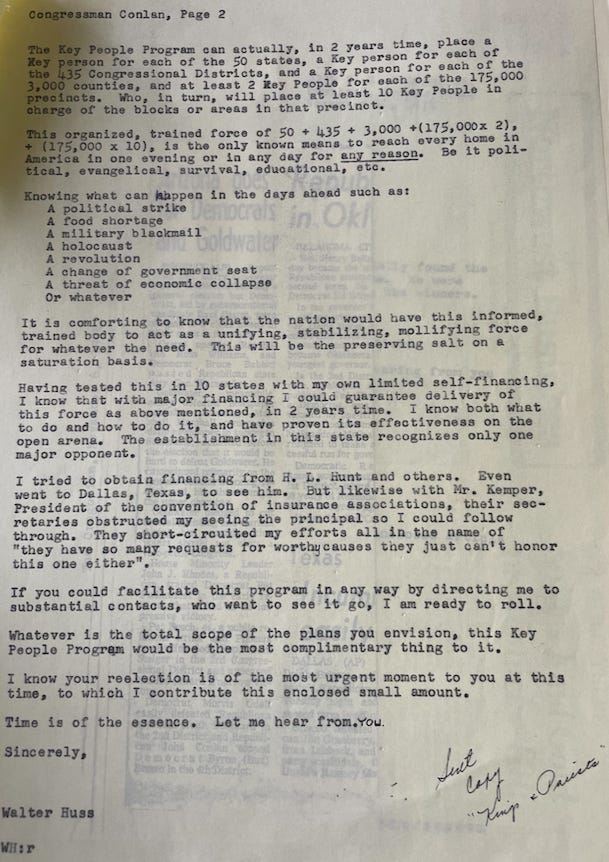
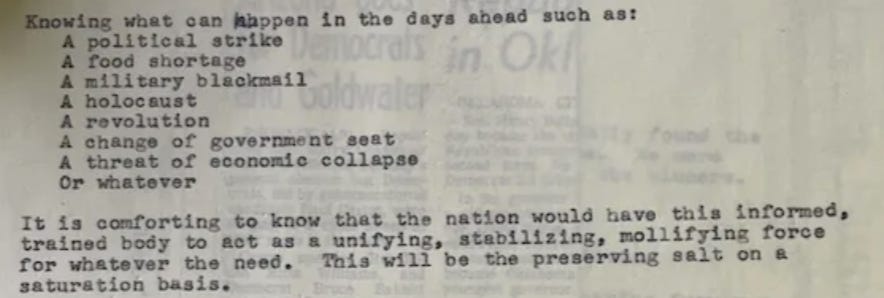
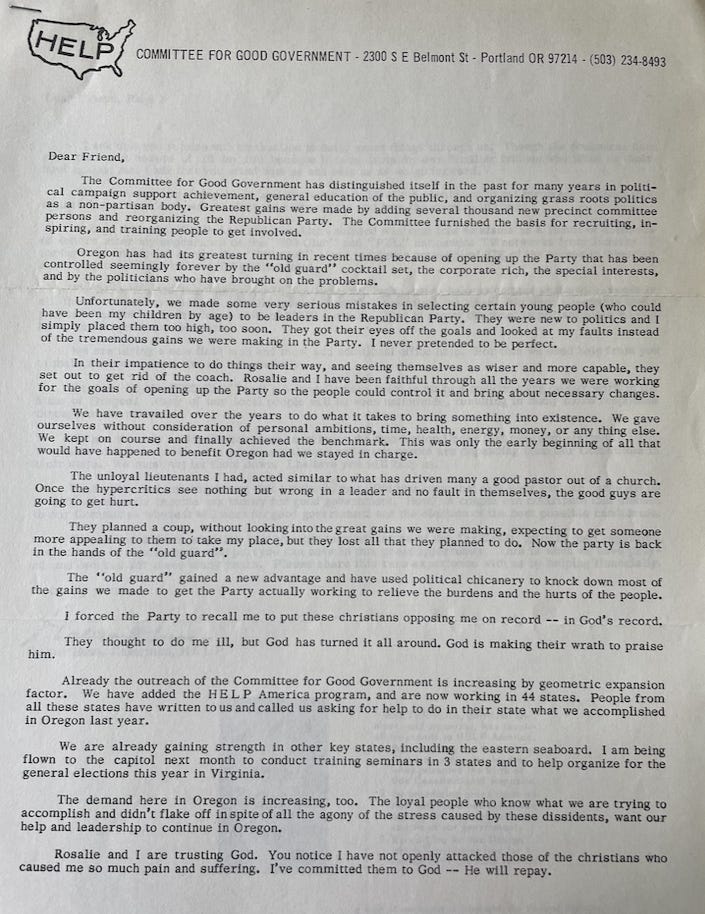
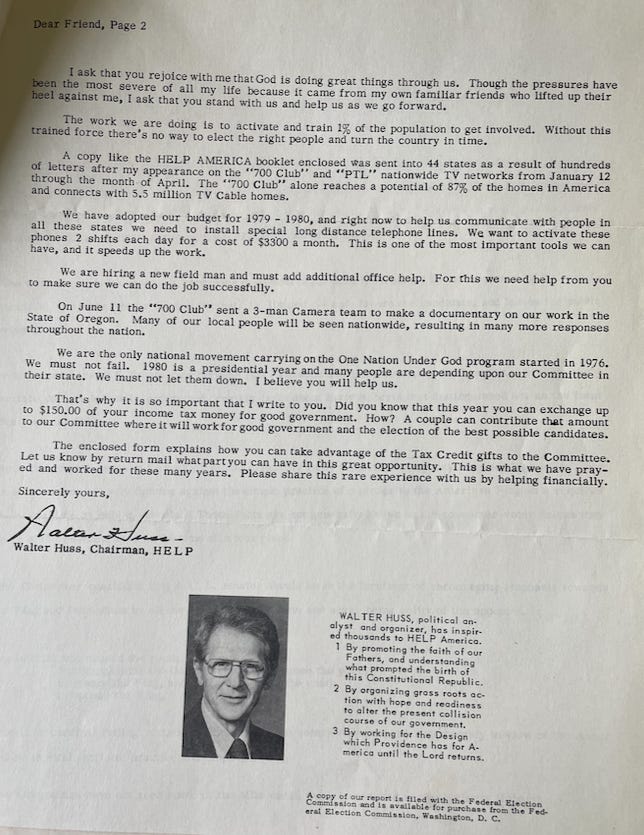
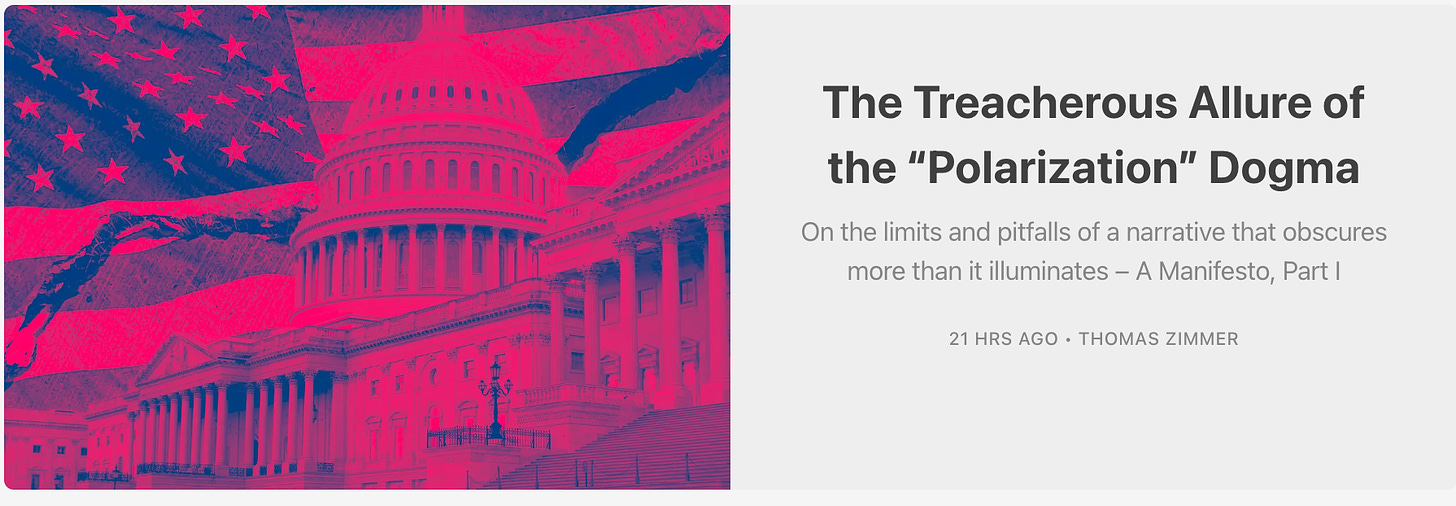

It was a good strategy and continues to work for the MAGA crowd today. I have to reflect on the fact that in their hands it seems scary and undemonstrative while I myself am a big believer in donating to progressives running in red states.
It was a good strategy and continues to work for the MAGA crowd today. I have to reflect on the fact that in their hands it seems scary and undemonstrative while I myself am a big believer in donating to progressives running in red states.